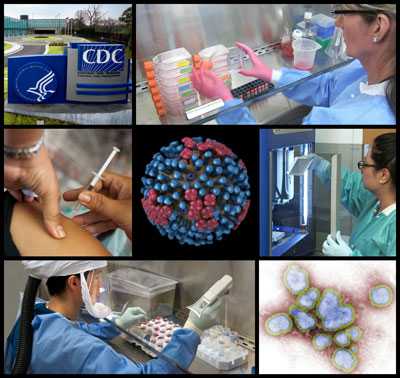CDC's World Health Organization (WHO) Collaborating Center for Surveillance, Epidemiology and Control of Influenza

Globally coordinated epidemiologic and virologic surveillance is the foundation of the influenza vaccine virus selection and development process and is a critical component of pandemic preparedness. The World Health Organization’s Global Influenza Surveillance and Response System (GISRS) was established in 1952 to monitor the frequent changes in influenza viruses with the aim of reducing influenza disease impact through the use of vaccines containing currently circulating strains. The GISRS network consists of national influenza centers (NICS) which conduct influenza virus surveillance and study influenza disease trends. There are also a number of designated WHO Collaborating Centers that conduct further research and analysis on information and samples gathered by the NICS. Currently there are 142 NICs in 112 countries around the world and 6 WHO collaborating centers. Twice a year, WHO convenes technical consultations (vaccine composition meetings) to make recommendations on the viruses to be included in influenza vaccines for the following influenza seasons in the Northern and Southern Hemispheres, respectively. The committee assembled by WHO comprises representatives from the 6 WHO Collaborating Centers and four Essential Regulatory Laboratories (ERLs, in Australia, Japan, UK and USA) with observers from other laboratories NICs and other expert groups.
CDC’s Influenza Division has served as a WHO Collaborating Center (CC) for Surveillance, Epidemiology, and Control of Influenza in Atlanta, Georgia since 1956 and is the largest global resource and reference center supporting public health interventions to control and prevent pandemic and seasonal influenza.
What We Do
As a WHO Collaborating Center, CDC’s Influenza Division plays a major role in year-round surveillance for early detection and identification of antigenically drifted seasonal influenza viruses as well as novel influenza A viruses that may have pandemic potential. The Influenza Division collects and analyzes influenza viruses from around the world for epidemiological, antigenic (immune response), antiviral susceptibility and genetic characterizations.
The Center also is responsible for making candidate vaccine viruses. Candidate vaccine viruses are prepared flu viruses used by vaccine manufacturers to mass produce flu vaccines. Together with other WHO CCs (Melbourne, Australia; Beijing, China; Tokyo, Japan; London, United Kingdom; Memphis, USA), CDC’s Influenza Division provides essential information for the WHO to make recommendations on appropriate viruses to be included in annual seasonal influenza vaccines as well as vaccines for pandemic preparedness.
CDC’s Collaborating Center also maintains a repository of influenza specimens and virus isolates from worldwide sources. These viruses are made available to WHO laboratories, vaccine manufacturers, other public health partners and research institutions. In addition, CDC’s Collaborating Center conducts public health oriented research, produces and supplies diagnostic reagents for members of the WHO/GISRS and other institutions, and provides assistance for outbreak investigations, technical assistance and capacity building, including laboratory and epidemiologic training to strengthen and expand the WHO GISRS.
The WHO Pandemic Influenza Preparedness (PIP) Framework was adopted in 2011 with the goal of improving global preparedness in the event of an influenza pandemic. CDC’s Influenza Division participates in the PIP Framework through the receipt and analysis of potential pandemic viruses, as well as sharing of these viruses, data and expertise through appropriate systems established through the Framework.
CDC Collaborating Center Terms of Reference (2014)
Together with WHO, the Collaborating Centers work on a wide variety of activities in support of their Terms of Reference. CDC’s WHO Collaborating Center’s Terms of Reference (2014) are as follows:
- To maintain national and international virologic and disease surveillance for influenza, contribute data to WHO/GISRS for influenza vaccine virus selection and provide laboratory and epidemiologic assistance for outbreak investigations.
- To evaluate the impact of influenza epidemics and to initiate collaborative research to increase knowledge on the epidemiology and burden of disease of influenza and other respiratory diseases.
- To evaluate the effectiveness of current seasonal influenza vaccines and develop new types of vaccines for protection against influenza.
- To evaluate the effectiveness of and monitor the susceptibility of influenza viruses to antiviral drugs, to inform public health recommendations.
- To provide technical assistance and capacity building, including laboratory and epidemiologic training, to strengthen and expand the WHO GISRS.
- To produce and supply epidemic and pandemic vaccine reference strains and diagnostic reagents for members of the WHO/GISRS and other institutions.
- To develop, evaluate and standardize laboratory diagnostic, virologic and immunologic tests to establish new approaches for vaccine virus selection.
- To adhere to Terms of Reference specified in the ANNEX 5 of PIP Framework (http://www.who.int/influenza/resources/pip_framework/en/index.html as relating to WHO Collaborating Centers for Influenza Terms of Reference related to work with pandemic influenza preparedness.
Center Staff:
Dr. Jacqueline Katz, Ph.D. – Director
Dr. Xiyan Xu, MD – Deputy Director
Contact and Location:
Institution: Influenza Division, National Center for Immunization and Other Respiratory Diseases
Centers for Disease Control and Prevention (CDC)
Address: 1600 Clifton Road, A-20, Atlanta, Georgia 30329
Related Links
- CDC Yearly Lab Work on Flu Viruses Infographic
- Fact Sheet [150 KB, 2 Pages, 8.5” x 11”]
- Global Influenza Surveillance and Response System (GISRS)
- Map of Collaborating Centers and Global Influenza Surveillance and Response System (GISRS)
- WHO Collaborating Centers Global Database
- CDC’s World Health Organization (WHO) Collaborating Center for Surveillance, Epidemiology and Control of Influenza
- WHO Collaborating Centres for influenza and Essential Regulatory Laboratories
- Information for WHO Collaborating Centers
- Selecting Viruses for the Seasonal Influenza Vaccine
- WHO Global Influenza Surveillance and Response System (GISRS) Surveillance and Vaccine Development
- Page last reviewed: November 24, 2015
- Page last updated: January 25, 2017
- Content source:
- Centers for Disease Control and Prevention, National Center for Immunization and Respiratory Diseases (NCIRD)
- Page maintained by: Office of the Associate Director for Communication, Digital Media Branch, Division of Public Affairs


 ShareCompartir
ShareCompartir